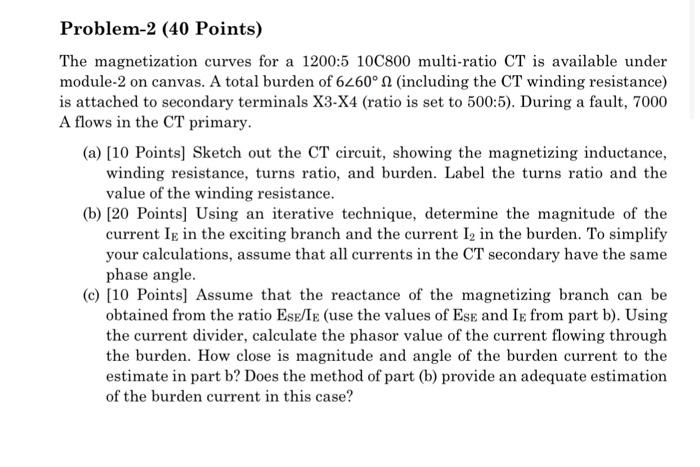
Problem-2 (40 Points) The magnetization curves for a 1200:5 10C800 multi-ratio CT is available under module-2 on canvas. A total burden of 6260 (including the CT winding resistance) is attached to secondary terminals X3-X4 (ratio is set to 500:5). During a fault, 7000 A flows in the CT primary. (a) [10 Points) Sketch out the CT circuit, showing the magnetizing inductance, winding resistance, turns ratio, and burden. Label the turns ratio and the value of the winding resistance. (b) [20 Points] Using an iterative technique, determine the magnitude of the current Ig in the exciting branch and the current I, in the burden. To simplify your calculations, assume that all currents in the CT secondary have the same phase angle. (c) [10 Points) Assume that the reactance of the magnetizing branch can be obtained from the ratio Esp/Ie (use the values of Ese and le from part b). Using the current divider, calculate the phasor value of the current flowing through the burden. How close is magnitude and angle of the burden current to the estimate in part b? Does the method of part (b) provide an adequate estimation of the burden current in this case? Problem-2 (40 Points) The magnetization curves for a 1200:5 10C800 multi-ratio CT is available under module-2 on canvas. A total burden of 6260 (including the CT winding resistance) is attached to secondary terminals X3-X4 (ratio is set to 500:5). During a fault, 7000 A flows in the CT primary. (a) [10 Points) Sketch out the CT circuit, showing the magnetizing inductance, winding resistance, turns ratio, and burden. Label the turns ratio and the value of the winding resistance. (b) [20 Points] Using an iterative technique, determine the magnitude of the current Ig in the exciting branch and the current I, in the burden. To simplify your calculations, assume that all currents in the CT secondary have the same phase angle. (c) [10 Points) Assume that the reactance of the magnetizing branch can be obtained from the ratio Esp/Ie (use the values of Ese and le from part b). Using the current divider, calculate the phasor value of the current flowing through the burden. How close is magnitude and angle of the burden current to the estimate in part b? Does the method of part (b) provide an adequate estimation of the burden current in this case







